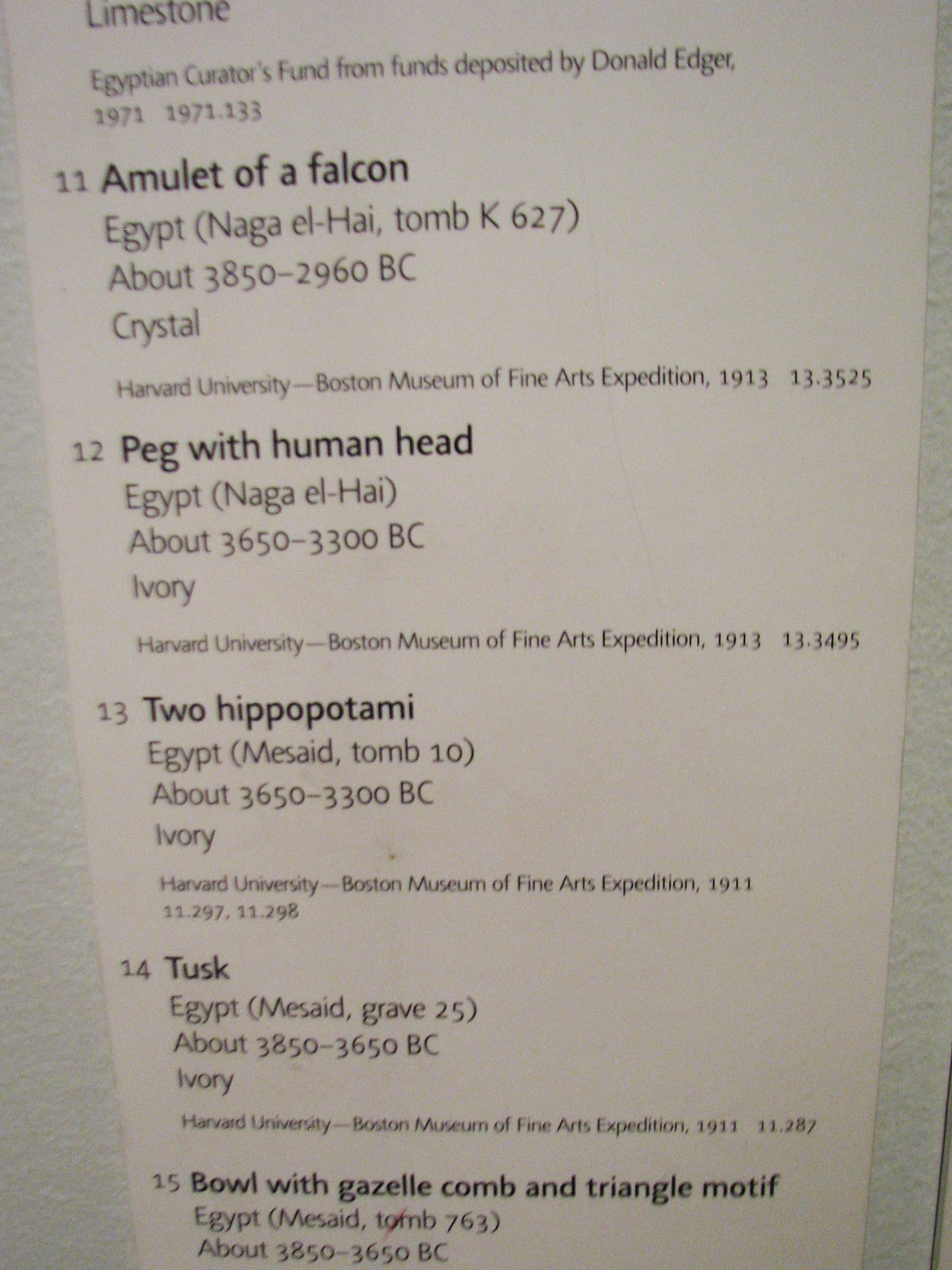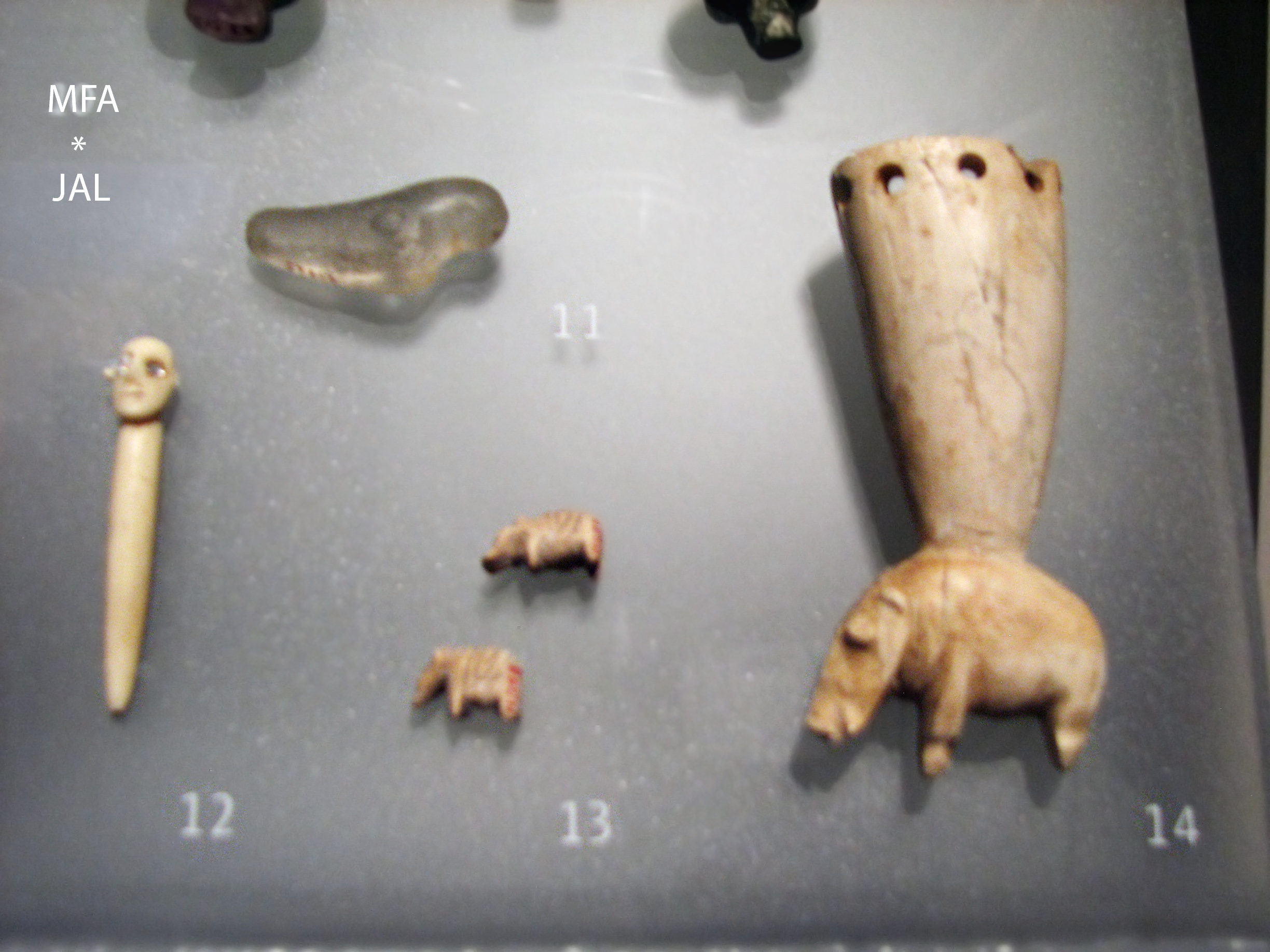
11 Amulet of a falcon
Egypt, (Naga el-Hai, tomb K 627O), about 3850-2960 B.C.E.
Crystal, Length: 3.8 cm (1 1/2 in.)
Harvard University-Boston Museum of Fine Arts Expedition 1913, MFA #13.3525
12 Peg with human head
Egypt, (Naga el-Hai), about 3650-3300 B.C.E.
Ivory, Length: 5.3 cm (2 1/16 in.)
Harvard University-Boston Museum of Fine Arts Expedition 1913, MFA #13.3495
13 Two hippopotami
Egypt, (Mesaid, tomb 10), about 3650-3300 B.C.E.
Ivory, Length: 1.5 cm (9/16 in.)
Harvard University-Boston Museum of Fine Arts Expedition 1911, MFA #11.298
14 Tusk
Egypt, (Mesaid, grave 25), about 3850-2960 B.C.E.
Ivory, Length: 8.6 cm (3 3/8 in.)
Harvard University-Boston Museum of Fine Arts Expedition 1911, MFA #11.287
Photo © Joan Ann Lansberry
"This unusual object, carved from the tooth of a hippopotamus and terminating in a figure of a hippopotamus, may have served as a container for a substance believed to have magical powers. Such items were worn around the neck on leather strings." (Museum website description)
Amulet of a bull's head
The next piece I'm determining by description:
Photos © Joan Ann Lansberry, except for two tiny ones from museum website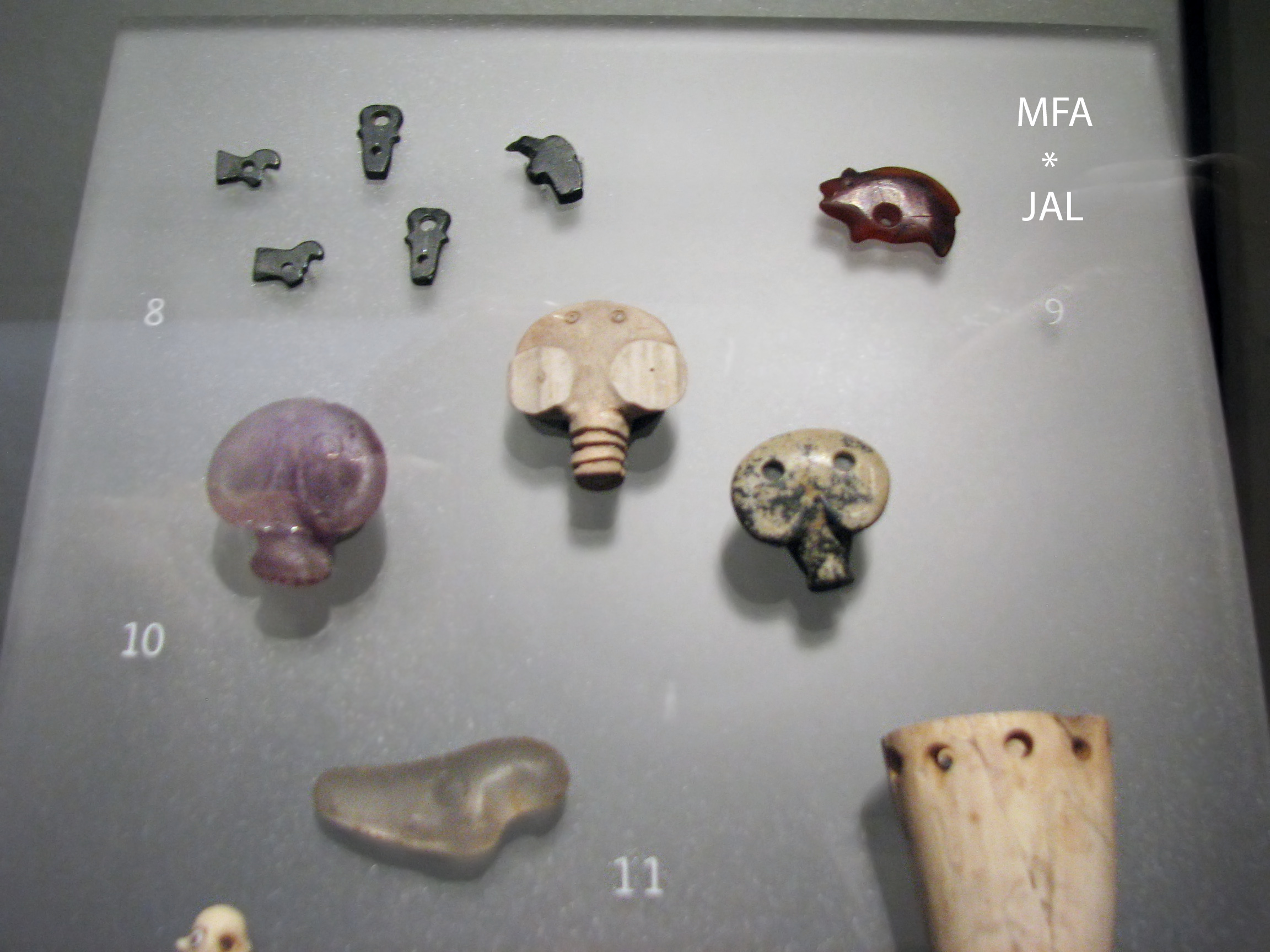
Amulet,
Falcon amulet,
Amulet depicting the goddess Bat,
Vulture amulet,
Falcon amulet
Egypt, Naga el-Hai (Qena), Amazonite, Harvard University—Boston Museum of Fine Arts Expedition 1913, MFA #13.3499a-e
"This group of flat, dark stone amulets were found together in a tomb and are probably elements of the same necklace. Included are a vulture, birds that are likely falcons, and schematic bovine heads with curved horns. Cattle played a prominent role in Predynastic and Early Dynastic religion. One of Egypt's earliest attested deities was a solar cow goddess, while the bull became a symbol of power directly associated with the king. The vulture would eventually become one of Egypt's most popular protective symbols." (From museum website)
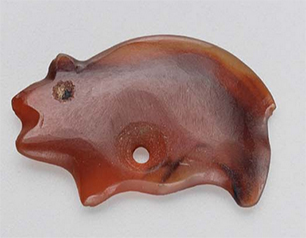
Amulet in the form of an animal
Egypt (Mesaid (Mesa'eed) tomb 179), 3650–3300 B.C.E.
Carnelian, Height x length: 1.8 x 2.6 cm (11/16 x 1 in.)
Harvard University—Boston Museum of Fine Arts Expedition 1911, MFA #11.1086
Egypt, 2960–2770 B.C.E.
Amethyst, Length: 2.9 cm (1 1/8 in.)
Gift of Estate of Mrs. Francis C. Lowell 1922, MFA #22.552
Amulet of a bull's head Or does this one appear more like an elephant head?
Egypt (Zawiyet el-Aryan), 2750–2649 B.C.E.
Ivory, Length: Length x width: 3.2 x 2.9 cm (1 1/4 x 1 1/8 in.)
Harvard University-Boston Museum of Fine Arts Expedition 1911, MFA #11.2641
Amulet of a bull's head
Egypt, Naqada I–III, 3850–2960 B.C.E.
Limestone, Length: 2.5 cm (1 in.)
Egyptian Curator's Fund from funds deposited by Donald Edgar 1971, MFA #1971.133
"Amulets of this type–a stylized animal head with round eyes, long, curved horns and a downward-pointing snout–are thought to represent bulls. They were worn to impart verility and fertility to the wearer." (Museum website description)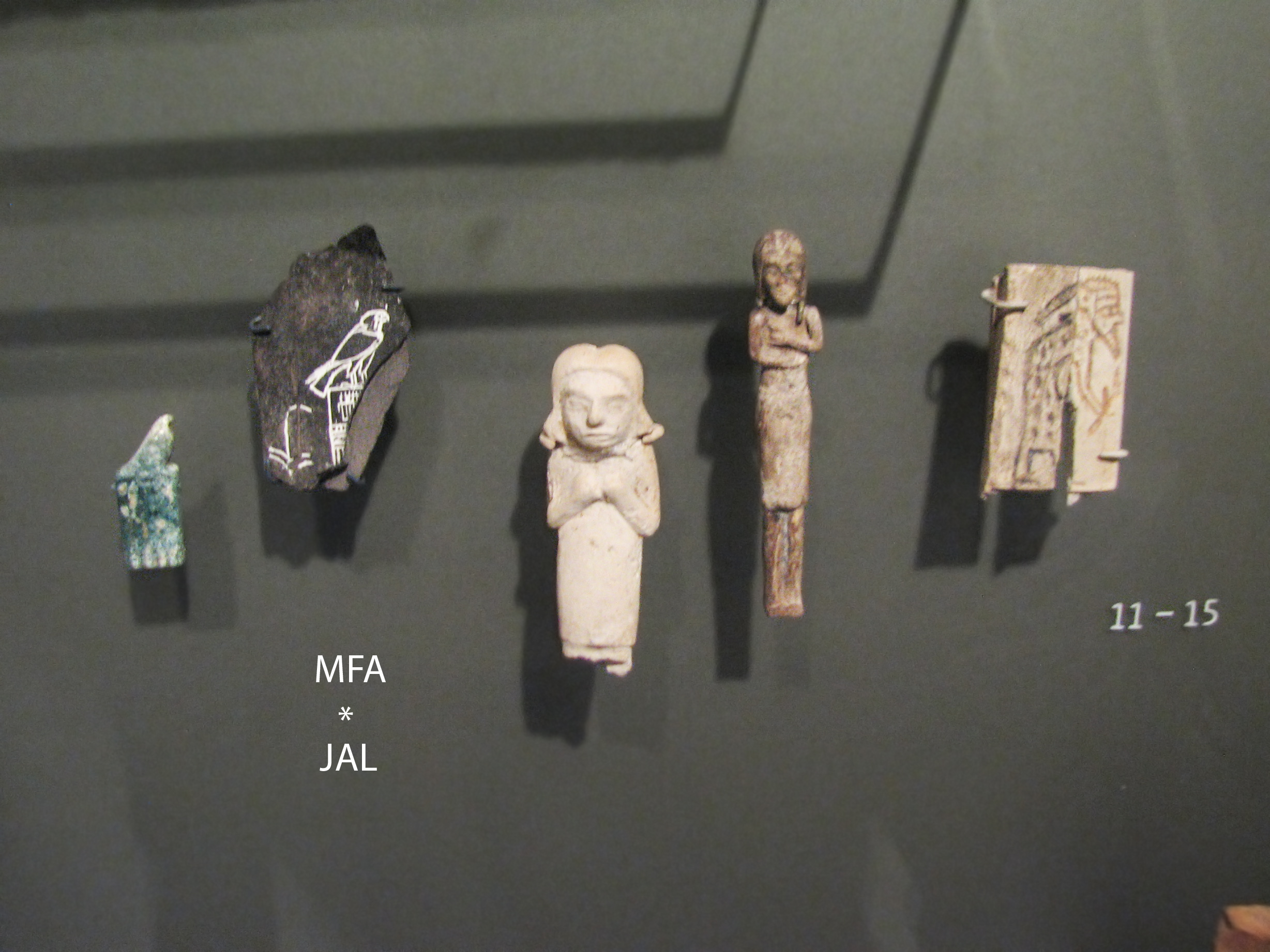
No info card photographed for these tiny pieces, but by seeking for time eras, I was able to turn up a few: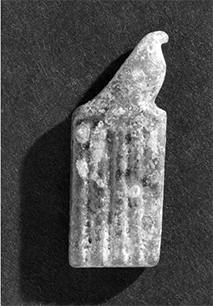
Serekh
Egypt (Giza), 2960–2770 B.C.E.
Faience, 2.7 cm (1 1/16 in.)
Egyptian Research Account by subscription 1907, MFA #07.565
Two transverse holes suggest that this is a bracelet element.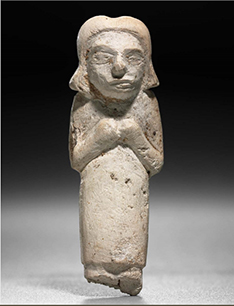
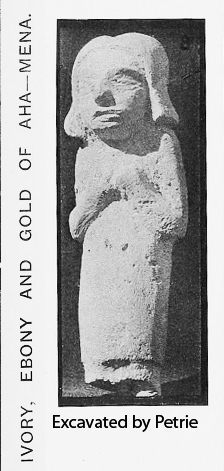
Figurine of a girl
Egypt (Abydos, tomb of Benerib), 2960–2770 B.C.E.
Ivory, Excavated by Petrie
Egyptian Research Account by subscription 1901, MFA #01.7367
"Hair long and parted in middle; small pointed beard; hands on breast; wears a short tight garment to the knees. Feet missing."
Figurine of a girl (Perhaps the 'small pointed beard' is really a pointy chin?)
Egypt ( Abydos, temple), 2960–2770 B.C.E.
Ivory, Height: 6.8 cm (2 11/16 in.)
Egyptian Research Account by subscription 1903, MFA #03.1806
